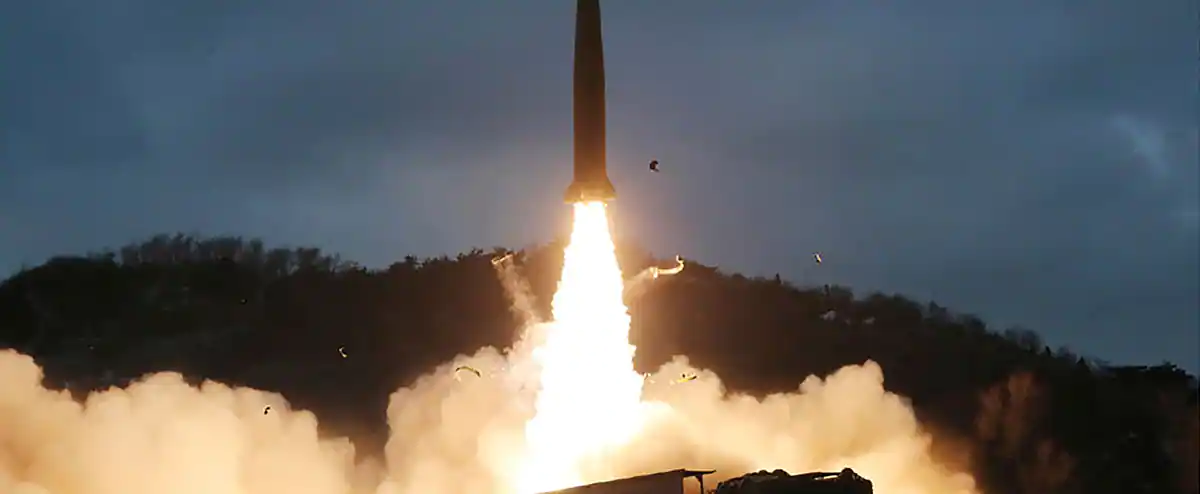North Korea fired a ballistic missile on Sunday, the eighth this year, after a month of lull during the Beijing Olympics and as international attention is focused on Ukraine.
• Read also: Ballistic missile tests: North Korea is “in the provocation phase”, according to Antony Blinken
The South Korean army has “detected a ballistic missile launched in the direction of the East Sea” (the Sea of Japan), the South Korean army said in a statement.
The projectile, launched at 2252 GMT Saturday from Sunan, near Pyongyang, traveled about 300 km at a maximum altitude of 620 km, she added.
The South Korean presidency expressed its “deep concern” over the launch, which comes “at a time when the world is striving to stop the war in Ukraine”.
In January, North Korea had fired seven, a record number in a month, including that of its most powerful missile since 2017, while negotiations with the United States have stalled.
The regime has also warned that it may drop its self-imposed moratorium on intercontinental ballistic missile (ICBM) and nuclear testing.
North Korea refrained from any weapons testing during the Beijing Winter Olympics, perhaps out of respect for its neighbor and ally China. However, with the international community’s attention focused on the war in Ukraine, many analysts expected Pyongyang to take the opportunity to resume firing.
“They are restarting the machine,” Shin Beom-chul, a researcher at the Research Institute for Economy and Society, told AFP.
“They refrained from any provocation during the Beijing Games to spare their relations with China. But when the interest of the United States turned to Europe with the crisis in Ukraine and the Security Council proved unable to function, Pyongyang seized the opportunity, ”explained this analyst.
On Saturday, North Korea held the United States responsible for the war in Ukraine, in its first official reaction to the Russian invasion.
“The root cause of the Ukrainian crisis lies (…) in the authoritarianism and arbitrariness of the United States,” said a message published on the website of the North Korean Ministry of Foreign Affairs.
“Addiction” to missiles
“North Korea was not going to please anyone by sitting still while the rest of the world deals with Russia’s aggression against Ukraine,” said Leif-Eric Easley, a professor at Ewha University in Seoul.
As North Korea’s economy suffers from international sanctions and the draconian isolation the country has imposed on itself to protect itself from the pandemic, “the strength and legitimacy of the Kim regime now depend on ever better missile tests “, he added.
This new show of force from Pyongyang comes as South Korea prepares to elect its next president on March 9.
The outgoing South Korean President, Moon Jae-in, has repeatedly warned that the Peninsula could at any time plunge back into the crisis it went through five years ago, if Pyongyang resumes its firing of intercontinental missiles or even its nuclear tests.
Parade in preparation
Analysts believe Pyongyang could use the most important date on its political calendar, April 15, to carry out a major weapons test.
This date marks the anniversary (110 years this year) of the birth of Kim Il Sung, founder of North Korea and grandfather of current leader Kim Jong Un.
Recent satellite images suggest that the North Korean regime is preparing a large military parade to show off its weapons for the occasion.
But for Park Won-gon, professor of North Korean studies at Ewha University, “North Korea will have to be careful about an ICBM launch, because it is its last card to put pressure on the United States”.
Since the inauguration of US President Joe Biden in January 2021, Pyongyang has rejected the various dialogue proposals made by Washington. And Kim Jong Un reaffirmed in December that his priority was to modernize the country’s arsenal.
North Korea threatened on January 20 to resume its nuclear or missile tests, saying it was forced to do so by the “hostile” policy of the United States towards it. And ten days later, Pyongyang launched a Hwasong-12 intermediate and long range surface-to-surface ballistic missile, the most powerful projectile it had tested since 2017.
